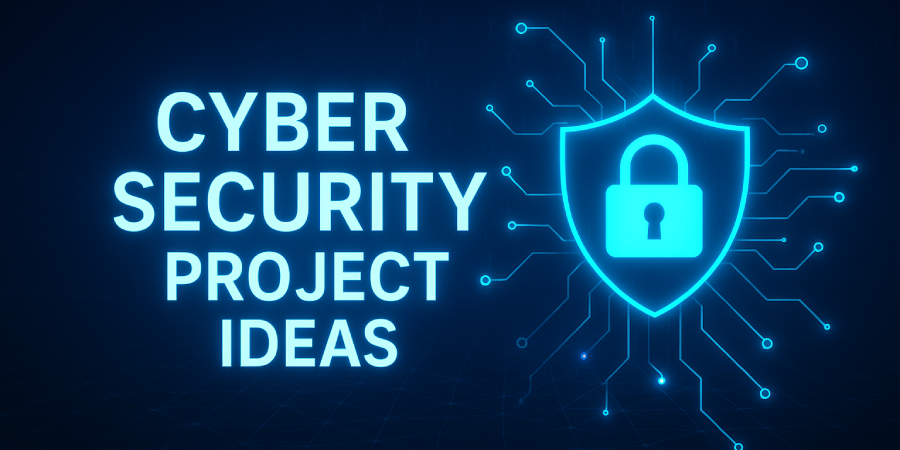If you’re a student studying IT or computer science, or even a working professional planning to switch to cybersecurity, doing real projects is one of the best ways to learn.
Projects help you understand how cyber threats work and how to protect systems from them. Plus, they make your resume stronger and help you stand out in interviews.
In this blog, we’ve listed the Top 20 Cyber Security Project Ideas for Students and Professionals. These ideas will help you gain practical knowledge and get ready for real-world challenges.
Top 20 Cyber Security Project Ideas For Students And Professionals
- Password Strength Checker
In this project, you can build a simple tool that checks how strong or weak a password is. It can analyse things like the length of the password, whether it has numbers, capital letters, special characters, and also spot common patterns like “123456” or “password”.
- Keylogger Detection Tool
For this project, you can create a tool that checks if any suspicious software is secretly recording keystrokes on a computer. Keyloggers are used by hackers to steal passwords and personal info, so your tool can look for unusual system behaviour, unknown background processes, or hidden files.
- Phishing Website Detector
In this project, you can work on building a tool that helps identify fake websites designed to steal user information. It can check things like suspicious URLs, spelling errors, unusual website structures, and whether the site has a valid security certificate (HTTPS).
- Web Application Vulnerability Scanner
This project is about creating a tool that can scan websites or web apps for common security issues. You can include checks for things like SQL injection, cross-site scripting (XSS), and open ports. The scanner can show a simple report that tells what vulnerabilities were found and how serious they are.
- SIEM Dashboard using ELK Stack
In this project, you can set up a basic Security Information and Event Management (SIEM) dashboard using the ELK stack—Elasticsearch, Logstash, and Kibana. The idea is to collect logs from different sources, like servers or applications, and display them in one place.
- Secure File Transfer Application
Think of this like a simple file-sharing app, but with safety in mind. The goal here is to make sure that when someone sends a file, it’s encrypted so no one else can read it, even if they somehow get access. You can build this using basic encryption methods and maybe add user login, file size checks, and a clean interface.
- Face Recognition Login System
In this project, you can build a simple login system where users can sign in using their face instead of typing a password. You can use a webcam to scan the face and compare it with stored data to allow access. It’s a cool way to explore how face detection and recognition work, and you’ll also get to understand how secure or risky biometric systems can be in real-world use.
- Encrypted File Storage System
This one’s about creating a system where files are stored in an encrypted format, so even if someone gets access to the storage, they won’t be able to read the content without the right decryption key. You can let users upload files, encrypt them automatically, and save them securely. When they want to access the file, they’ll need to enter a key or password to decrypt it.
- Two-Factor Authentication (2FA) System
This project is about adding an extra layer of security to the login process. Instead of just entering a password, users will also need to verify their identity using a second method, like an OTP sent to their email or phone. You can build a simple system that checks the password first and then sends a randomly generated OTP to the user for final confirmation.
- Ransomware Simulator (Safe Version)
In this project, you can create a demo version of ransomware—but don’t worry, it won’t actually harm anything. The idea is to simulate how ransomware works by locking or encrypting dummy files and then showing a message asking for a “ransom”. This helps you (and others) understand how these attacks happen and how they affect systems.
- Cryptographic Key Management System
This project is all about managing encryption keys in a safe and organised way. You can build a system where keys are generated, stored securely, and shared only with authorised users. It should also handle tasks like key rotation, expiration, and backup. It’s a solid project if you’re interested in how big companies manage sensitive data and keep their encryption systems in check.
- Network Vulnerability Scanner
This project involves building a tool that scans a computer network to find weak points that hackers might try to exploit. Your scanner can check for open ports, outdated software, or misconfigured settings. You can also add a simple report that shows the risks found and gives suggestions to fix them. It’s a practical way to learn how networks are tested for security issues in real life.
- IoT Security Survey
For this project, you can do a small research-based study on how secure IoT (Internet of Things) devices are—like smart TVs, fitness bands, CCTV cameras, or smart plugs. You can collect data through surveys, check common default settings, and even test basic vulnerabilities (like weak passwords or open ports).
- Wi-Fi Network Sniffer
In this project, you can build a tool that scans and lists all nearby Wi-Fi networks along with details like signal strength, security type, and MAC address. You can also explore how data packets travel over Wi-Fi and how attackers might try to capture them. It’s a great way to understand wireless network security and what kind of risks are involved if proper protections aren’t in place.
- Login Brute-force Detection System
This project focuses on detecting when someone is trying to guess a password by trying many combinations again and again—a method known as a brute-force attack. You can create a system that keeps track of failed login attempts and locks the account, or shows a warning if too many wrong tries happen in a short time.
- Firewall Log Analyzer
This project is about creating a tool that reads and analyses logs from a firewall to spot any unusual or suspicious activity. You can design it to highlight things like repeated access attempts, blocked IPs, or traffic from unknown sources. It helps in understanding how firewalls protect networks and how log data can be used to strengthen overall security.
- Intrusion Detection System (IDS)
This is the kind of project where you build something that keeps watching over a network and alerts you if it notices anything odd. For example, if someone is trying to access data they shouldn’t or if there’s an unusual amount of traffic, your system can send out a warning. You don’t have to make it too complex; just setting a few basic rules or patterns to watch out for is a good start.
- Digital Footprint Analyzer
This project is all about checking what kind of personal information is floating around on the internet about someone. You can build a simple tool where users enter their name, email, or phone number, and it searches the web to show where their data appears, like on social media, public forums, or leaked databases.
- Blockchain-Based Voting System
In this project, you can create a basic online voting system that runs on blockchain technology. The main idea is to make sure that every vote is recorded safely and can’t be changed later. You can use blockchain to keep track of votes transparently and securely, so no one can cheat or tamper with the results.
- Secure QR Code Generator
For this project, you can build a tool that creates QR codes with an extra layer of security. Many people scan QR codes without checking if they’re safe, so your tool can make sure the links inside are verified and not harmful. You can also include features like link previews, expiry time for the code, or alerts if someone tries to tamper with it.
How to Choose the Best Cyber Security Project Topics
- Know your comfort level
If you’re just starting out, go for something simple like a password strength checker or phishing website detector. Don’t jump straight into complex tools unless you’re confident with coding or networking. - Play to your strengths
Are you better at coding, researching, or designing? Pick a project that fits your interest. For example, if you enjoy research, an IoT security survey is a great choice. If you love coding, try building a secure chat app or a login system. - Think about real-world use
Choose a topic that’s relevant today. Projects like QR code security or ransomware simulation are great because they reflect real problems happening in India and across the world. - Check what’s needed in the industry
If you’re planning to apply for internships or jobs, look at job descriptions. If most of them mention network security, you can try projects like firewall log analyzers or intrusion detection systems. - Work with what you have
Choose a project based on the tools, time, and system you already have. Don’t stress if you don’t have access to high-end machines or software. Many great projects can be done with just a laptop and some creativity.
Conclusion
Cybersecurity is something we all should know about these days, not just people working in big IT companies. If you’re a student or a working professional, doing small projects is a great way to learn how online security really works.
Pick any project that sounds interesting to you and give it a try. You don’t need to make it perfect, just start. Even a small project can teach you a lot and open up new opportunities in the future.
Frequently Asked Questions
Q1. I’m a beginner in cybersecurity. Can I still try these projects?
Ans: Yes! Many of these projects are beginner-friendly. You can start with simple ones like a password strength checker or phishing detector, and slowly move to advanced ones as you learn.
Q2. Do I need to know coding for these cyber security projects?
Ans: For most projects, basic knowledge of coding (like Python or JavaScript) is helpful. But some ideas like surveys or research-based projects, need more analysis than coding.
Q3. Will these projects help me get a job or internship?
Ans: Yes, they can! Doing hands-on projects shows that you have practical skills. It also makes your resume stand out and gives you something to talk about in interviews.
Q4. Can I do these projects without any paid tools?
Ans: Yes. Many cybersecurity tools are open-source and free. For example, Wireshark, ELK Stack, or even Python libraries can be used for most of these projects.
Q5. How do I choose the right cyber security project for me?
Ans: Think about your interests. If you like coding, try building a tool. If you enjoy analysis, go for a survey or vulnerability scan. Start small and grow from there.

















